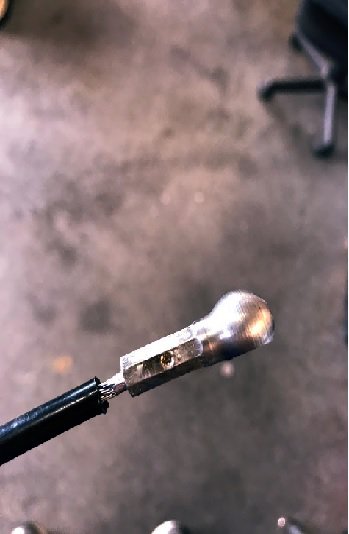Sorry if this has been posted before but I have not found a post on this specific issue.
I recently had one of my top tension cables break again. These are the single cables on each side of the top that hold tension on it when it's closed and give it a good shape when the top is closed. Not wanting to spend $60 to replace a single broken cable I decided to attempt a repair. So far the results are looking good.
The total length of the cable, not including the ends, is 9 inches. There is 8 inches of exposed cable and 1/2 inch inside each ball connector. The cable thickness is approximately 1/8 inch.
Rather than spend extra money for stainless cable, I purchased regular galvanized cable. We shall see how it works out.
Tools & Supplies needed:
-Dremel with cut-off wheel or similar tool
-Grinding wheel or Scotchbrite wheel
-Drill Press or power drill and steady hands!
- 1/8" cable either Stainless or Galvanized
- 9/64 drill bit
-3/32 drill bit
-Propane Torch
-Electronics Solder and Flux. I used solder that was a little less than 3/32" thick.
-Container with water for cooling the connections.
1. Remove the broken cable and the broken end. Save the plastic tube that the old cable slide through. Grind down the bits of cable that are sticking out of the broken end.
2. Placed the broken end in a Drill Press vice or bench Vice if using a hand power drill. As carefully as possible, drill out the broken cable with the 9/64" bit trying to stay as close to the center as possible. Drill down 1/2". Make sure there are no bit of broken cable left in the hole.
3. Turn the connector on it's side and drill a 3/32" hole perpendicular to the cable opening and just above the bottom of the cable opening. I drilled all the way through but it can probably go just into the cable opening you just drilled out.
4. Cut a 9" long piece of replacement cable.
5. Flux one end of the replacement cable and twist into the open end of the connector making sure to follow the existing twist of the cable. Twist the cable in until it hits the bottom of the connector.
6. With you propane torch lit, hold the cable with the connector end in the flame until the flux starts to bubble. Take your solder and stick it into the 3/32" hole you drilled. Once it starts to melt and fill in the cable, remove the connector from the flame. The solder will continue to melt for a little bit. When you see solder come out of the end of the connector around the cable you can stop adding solder if you wish.
7. Dunk the soldered end in the water to cool it and check your handy work. Grind off and rough spots or excess solder.
8. Take the other part of the broken cable with the connection that is not broken off and using your Dremel or cutting wheel, cut off the remaining original cable as close to the end of the connector and the repeat from Step #2. (Remember to place the plastic tube over the new cable before you solder the second end in place!)
9. Make sure both connectors are facing the same way before you solder the second connector in place.
As you can see the plastic tube does not melt if you are careful. The total cost for the cable, (30 feet), and the drill bits was $10. The cable is very secure and we'll see how long it lasts since there is not a lot of pull on these cables.



